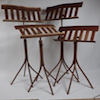I guess this could be more of a metal working question. But it is for my Dewalt GE ras so I would like to get some input from you guys.
I want to build a couple of 8ft x 24 extension tables for my RAS that are similar to the Original Saw Companys tables they sell for their RASs. I want to build it out of 1/4 steel for the top with a 20 wide x 30 tall set of industrial legs for the far ends with the other ends mounted to the saw on some angle iron.
I am curious to know from some of you guys how I could insure that the 1/4 steel top is flat? Would I need to find someone, perhaps a machine shop, with a large hydronic press? Could it be pressed flat? I dont want the expense of having it machined. I was quote $1,900 for having it machined flat. Any suggestions?




 Reply With Quote
Reply With Quote



